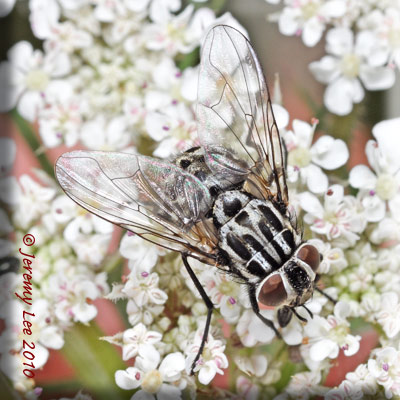
 |
|
Scientific Classifications explained » Amphibians » Ants » Aphids » Bees » Beetles » Birds » Bugs » Butterflies » Caterpillars » Damselflies » Dragonflies » Earwigs » Flies » Frog/Leafhoppers » Fungi » Galls » Grasshoppers » Harvestmen » Hoverflies » Lacewings » Ladybirds » Leaf Mines » Lichens » Mammals » Millipedes » Mosses » Moths » Sawflies » Slugs » Snails » Spiders » Trees & Shrubs » Wasps » Wild Flowers » Woodlice » Postboxes |
UK Nature > Flies > Graphomya maculata

Scientific Name: Graphomya maculata Common Name: Muscid Fly Graphomya maculata, more commonly known as a Muscid Fly, has an orangey-brown patterned abdomen in the males but females have a grey/black pattern (as above). Both have distinctive stripes on the thorax. Found in meadows, hedgerows and roadside verges nectaring on various flowers, especially umbellifers. On the wing from May to September/October. The larvae are predatory, feeding in muddy pools and damp leaf litter. Common and widespread in England and Wales. I am reliably informed that this could in fact be Graphomya picta, but to tell the difference between the common G. maculata and the scarcer G. picta depends on several distinguishing features, one of which is that in G.picta the abdomen is longer than it is broad, and vice cersa in G.maculata. From memory, and also from what I can see of the abdomen in this photograph, it would appear broader than than it is long, which would indicate that this is G. maculata. |
|

https://www.uknature.co.uk is a website dedicated to showing the immense diversity of UK nature and wildlife. Our vast range of habitats, from lowland arable to snow covered mountains, from storm-ravaged coastlines to peaceful inland freshwater lakes and rivers, from dry, sandy heaths to deciduous and coniferous forests, all these habitats contribute to the abundance of UK nature. We have wild birds in huge numbers either residing or visiting our shores (597 recorded species as at July 2013) and we must also not forget the humble back garden with its grass lawns, flower beds filled with nectar rich flowers, shrubs and trees, all designed to attract huge numbers of insects such as bees, moths, butterflies and hoverflies; and finally the small ponds which provide safe havens for frogs, toads, newts and even slow worms and grass snakes. www.uknature.co.uk is the showcase for my personal passion, photographing uknature in all its glory. I sincerely hope you all enjoy the fruits of my labours. This site and all images contained therein is © Jeremy Lee 2004 - 2025. All Rights Reserved. Site design by Jeremy Lee. Site development & IT Support by Stuart Lee. |